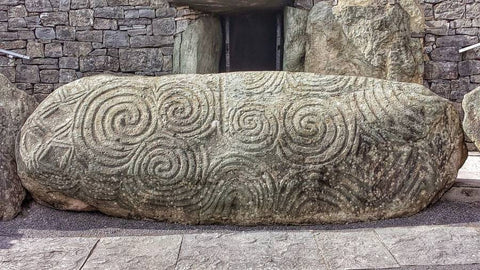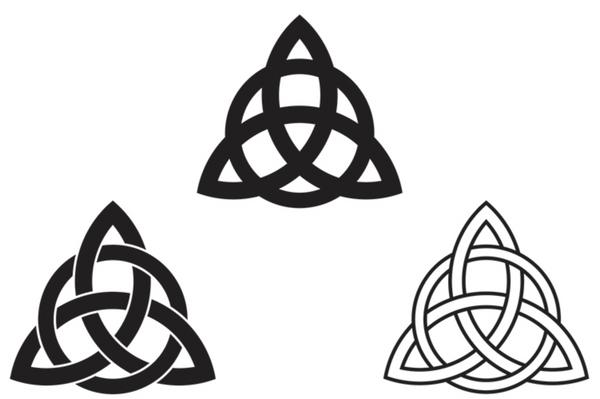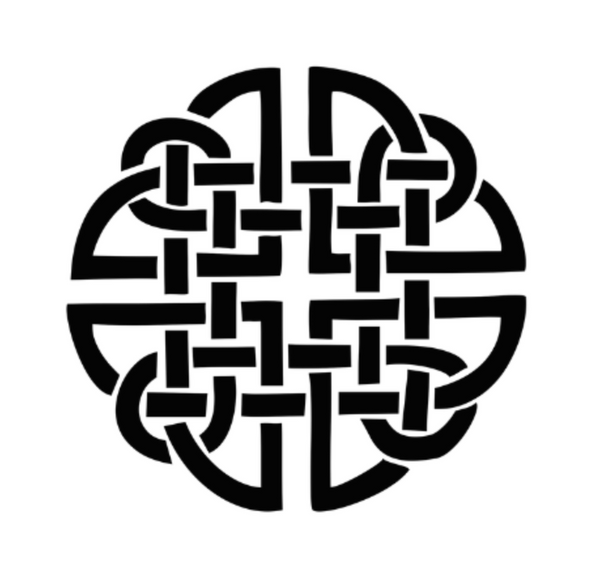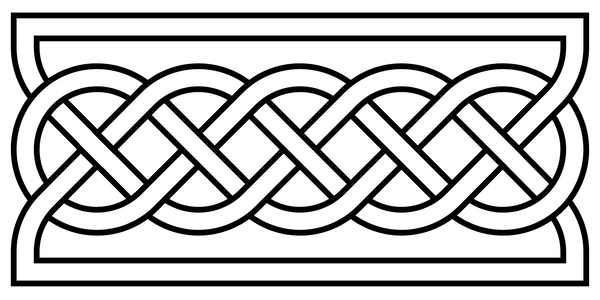There are some who would suggest that Celtic knots and Celtic knotwork — which give life to powerful symbols closely tied to Ireland and Irish identity — are also symbolic of the origins of the universe.
If that gives greater meaning and significance to Celtic knots and knotwork, well, we’re certainly not going to argue with that!
No matter which type of Celtic knot you might be looking at — whether it’s one you doodle in your notebook, a wood-carved artwork or a favorite piece of jewelry—the common theme of the Celtic knot is its infinite swirl.
As much as anything, Celtic myth and Celtic spirituality and the Celtic knot that represents so much of that is about those ideas of “neverendingness”, interconnectedness and universal harmony.
We are here. We are one. The molecules in our bodies are made from the dust of long exploded stars.
In the rest of this article we will explore these wonderful Celtic knot symbols in more detail. We will go through what we know of their history and their symbolic meaning, relevance and significance. We will show you the different types of Celtic knots, and will also draw your attention to the beautiful ways in which artists and creators are taking Celtic knots and knotwork to the world in their work.
Let’s jump in!
What is a Celtic knot?
Celtic knots are a type of intricate decorative design that features interwoven lines and knots. They have their origins in the Celtic culture, which spanned almost two thousand years, from around 1200 BC to around 500 AD.
There are many different types of Celtic knot, and we will go through several of them in a bit more detail below.
Today, Celtic knots in their various forms are used in jewelry, art and design, playing a modern role in an ancient concept: by wearing a piece of jewelry or owning a piece of art, people all over the world can find themselves reconnected once again to an ancient and vital interconnectedness, one that has in many cases been lost, forgotten or momentarily overlooked by the day-to-day norms of the modern world.
What is the history of Celtic knots?
Celtic knots are a subset of Celtic art and culture, and most remnants of them are primarily found today in Ireland as well as other western Celtic heartlands in Scotland and Wales.
That said, Celtic art as a concept is something that is not very precise and can lead to different interpretations and conclusions by different art historians. In recent years many art historians have taken to renaming Celtic art style as something called La Tène style, named after a site in Switzerland.
The Celts were a diverse bunch: the Hallstatt culture which dominated much of Europe (around what is now France, Italy, Switzerland and Germany and as far east as Poland and as far south as Serbia) during the late Bronze Age and early Iron Age, or from around 1200 BC to 600 BC, was effectively a Celtic culture.
Celtic knots were often used as a form of meaningful decoration, for example on stone carvings at important sites. One of the most famous examples of a Celtic knot might be the tri-spiral carved into the stone at the UNESCO World Heritage site of Newgrange.

Celtic knot spirals at UNESCO World Heritage site of Newgrange
Celtic knots were also believed to have magical and protective properties, and were often used in jewelry and other adornments. The intricate designs of Celtic knots are often said to represent the endless cycle of life, death, and rebirth, as well as the interconnectedness of all things in the natural world.
In Irish culture specifically, Celtic knots have a deep significance and are often associated with the ancient Celtic gods and goddesses. For example, the famous triskele knot, which features three interlocking spirals, is commonly said to represent the triple deity of the three ancient Irish or Celtic goddesses: Banba, Fodla, and Ériu, for which Ireland—Éireann—takes its name.
Shop our authentic leather cuff adorned with the triskele symbol.
The neverending nature of Celtic knots is associated with birth, death and rebirth, and as such is often linked to Celtic and ancient Irish beliefs in the afterlife.
Indeed, belief in the afterlife and its rewards were so strong that battle-hungry men often went into war with absolutely no fear of death, as the moment of fleshly demise, as one might call it, was not an end but an entry point to another chapter in an endless journey.
What are the different types of Celtic knots?
There are many different types of Celtic knot, and the most commonly known being the Trinity Knot (also known as a “Triquetra”), the Dara Knot, the Shield Knot, the Lover's Knot and the Sailor's Knot.
Trinity Knot, or Triquetra
The Trinity Knot or Triquetra is one of the most famous of all Celtic designs. It consists of three interlocking ovals or arcs, sometimes interlaced by a circular ring symbol, and can be found in one of the world’s most famous manuscripts, the Book of Kells, which can be viewed at Trinity College Dublin.

Dara Knot
The Dara Knot is a representation of a famous Irish tree. Dara derives from the old Gaelic word of Doire, meaning Oak Leaf. County Derry, which neighbors Donegal in north-west Ireland, has long been known as “the Oak Leaf County”.
As would befit something with oak tree connotations—this native Irish tree is known as “the mighty oak”—the Dara Knot symbolizes strength, durability and wisdom. The mythology suggests that the delicate intricacies of the Dara Knot represent the intricacies of the root system of a massive tree.
This knot offers further evidence of the connections between all living things, especially where those connections are unseen, as is the case in both the ethereal spirit and the underground root system.
There are many different variations of the Dara Knot.

Shield Knot
The Shield Knot is another Celtic knot variation. As you will no doubt realize by now, all the knots share the same neverending infinity loop and differ only in their representation of that concept.
The Shield Knot variation is typically a circle with four interlocking quadrants. In appearance, it can resemble a shield, with the central point—where the four quadrants connect—resembling the handle of the shield that would protect a warrior in battle.
Sometimes also known as a “Shield Cross”, which may be a remnant of the Christianization of Celtic concepts, this knot was sometimes also given as a symbolic remedy for the sick, in the hope that it would keep evil spirits at bay.

Lover's Knot
The Lover’s Knot or the Celtic Love Knot feature two interlocking hearts, upside down from one another. Again, it is a neverending loop. Trace your finger across the line of a Lover’s Knot and you might not really be able to determine where one heart becomes the other.
Again, this symbolizes interconnectedness and eternity.
What’s perhaps most interesting about the Lover’s Knot is that if the symbol dates from Celtic times, it predates the “love heart” by a millennium or more. The first written depiction of a love heart as a romantic symbol came in medieval France in the 13th century.

Sailor's Knot
The Sailor’s Knot is a wide oblong-shaped symbol which—as the name would suggest—might owe its origins to the ropes that would have been so indispensable to sailors and seafaring warriors.
It’s not known for sure whether there was any practical use for these knots on ships, or whether it was more symbolic. There are some suggestions that a knot such as this would—like other knots above—also have signified concepts such as love and strength, two things which we might describe as invisible and indispensable in battle.

What role do Celtic knots play in storytelling?
As anyone who ever studied the concept of storytelling will tell you, the key parts of a story are a beginning, a middle and an end—just not necessarily in that order. (Quentin Tarantino took that to extremes, but we’ll leave that to one side for now!)
As we’ve seen above, Celtic knots symbolize many different essential concepts, such as strength, wisdom, durability, faith and love.
But symbolism at its best always has a story attached. We might understand the concept of love, for example, but that understanding does not come from thinking about the idea. It comes from the representation of that idea in a story.
Stories are the essence of who we are as people. Our world is built on narratives.
There’s a funny old Irish saying that goes something like, “If you get the name of an early riser, you can sleep till dinnertime”. The story, then, is what people believe, much more than what any objective reality might be—and in so many things, especially in matters of the heart, it’s debatable whether there is any such thing as an objective reality.
You can imagine stories being told in clans and tribes thousands of years ago. Those stories might have described the triple deities. They might have described the astonishing feats of a warrior in battle, and the gods-given synchronicities or coincidences that helped him emerge victorious. The stories might have references the three essential essences of earth, wind and fire, or the infinity loop of birth, death and rebirth.
As these were among the earliest days of writing, with little but stone spirals and engravings surviving today, one of the few things we know for sure is that stories were told, and stories were essential to the long-term equilibrium of the people and the maintenance of their morale to meet every challenge.
As symbols of essential concepts, knots and their representation—in fabric or rope or engraved in stone—are likely to have played an essential role.
Celtic knotwork in Irish artifacts
The Ardagh Chalice and Celtic knots

The Ardagh Chalice, which is on display at the National Museum in Dublin, is regarded as arguably the greatest treasure of the early Irish church.
It was discovered in 1868 near Ardagh, County Limerick by two young men digging for potatoes in a ring fort in Reerasta.
Part of a hoard of treasures known as the Ardagh Hoard, it was covered by a stone slab and is believed to date from around the eighth century, which suggests that it was fashioned at least a couple of centuries after the Celtic culture was supplanted by the new Christianity spread by St Patrick and others.
However, as with so much in early Christianity, it borrowed heavily from pre-existing Celtic cultures, which can be seen from the Celtic-inspired symbolism throughout, especially those knotwork symbols in the golf filigree spanning the top of the chalice.
Made of spun silver, gold, glass, amber and enamel, it is an astonishing treasure—and one which historians and speculators alike have long wondered about in relation to the much-sought-after Holy Grail, with some pointing out that the Ardagh Chalice was modeled on descriptions of the Grail recorded by Adomnán, the Irish abbot of the Columban monastery on the Scottish island of Iona.
Celtic knots and the Tara Brooch

Discovered in the County Meath seaside near Bettystown in 1850, the Tara Brooch is another of the great treasures of ancient Ireland.
Funnily enough, the brooch owes its name less to its true origins—about which not a lot is actually known—and more to the commercial clout of an early dealer, who saw the opportunity to squeeze a little more profit out of the treasure if he could somehow connect it to the Hill of Tara, the seat of the ancient Irish High Kings and situated inland about 20 miles from where the brooch was discovered.
Approximately one foot in length and weighing about eight ounces (or half a pound), the Tara Brooch is decorated in gold panels, glass studs, enamel and amber.
Look closely and you can see trinity or triple spirals cast by some intricate artist perhaps close to 1500 years ago.
The Sam Maguire Cup
Perhaps the most famous piece of silverware in modern Ireland is the Sam Maguire Cup, which is awarded every year to the winners of the All-Ireland Football Championship.
The Sam Maguire Cup is an outsized semi-replica of—or, at the very least, is heavily inspired by—the Ardagh Chalice.
The cup, named after a Cork republican and Gaelic footballer who died in 1927, was originally manufactured in 1928 and the second version—the first having been retired in 1988—is still the object of footballers’ dreams every year.
Almost identical to the Ardagh Chalice are the representations of Celtic knotwork in the band which spans the cup, passing between the two handles.
Celtic knots and knotwork in modern-day jewelry
For many people around the world, because of their long history and association with Celtic culture that goes way beyond the beginning of Christianity in Ireland, the symbols contained in Celtic knots and knotwork are an indelible link to a dim, distant, almost certainly spiritual and perhaps even heroic past.
It will be no surprise then that these Celtic symbols have become a recurring motif in everything from jewelry to art to the work of tattooists all over the world.
Here at RealIrish.com we’re proud to partner with some of the finest Irish jewelry manufacturers, and many of their products include vital and imaginative representations of these Celtic symbols.
See, for example, the gorgeous Silver Trinity Knot Ladies Ring from Solvar, a family-run jewelry manufacturer which has been crafting Irish jewelry in Dublin since 1941 and is now run by the third generation of the Obernik family. Struck by the volume of visitors to the famous Gap of Dunloe landmark in County Kerry, Nicky Obernik decided to explore the possibility of manufacturing Irish jewelry inspired by Ireland’s history and culture. Nicky’s grandson Marcus is a director of Solvar today.
You can also find the beautiful Women’s Window to the Soul pending or the silver and 10K gold Celtic Cradle of Life earrings by Keith Jack, a jewelry designer who was raised on the Celtic lore of Ireland and Scotland before taking his brand to Vancouver in Canada some time ago.
FIND MORE FROM KEITH JACK HERE
And among other Celtic knotwork-themed products we also stock this Sterling Silver Necklace by Shanore.
Shanore is an Irish business founded by jeweler Frank Maher and now run by the second generation of the family’s Celtic jewelry devotees. Shanore has been designing, prototyping, testing and carefully crafting jewelry based on Celtic themes, symbols and lore for more than 40 years.
Recap
There you have it. A whistlestop tour through 2000 years of Irish and Celtic history, mythology and lore through the prism of these precious, priceless symbols.
We don’t know everything about Celtic symbolism.
But we do know enough that we can feel deeply connected to the earth beneath us, to the sky above us and to our ancestors from all those millennia ago, whether direct or indirect, who might be long forgotten to history now but whose energy and spirit still might hover in the ether.
If we can take from those ethereal memories some of those people’s hope and wisdom, some of their depths of strength and an undimmed love that endured all through life and the afterlife, then surely all of us can step forward and face our own day-to-day tasks with more optimism, more confidence and more faith.
I’d love to hear your thoughts about this article on Celtic knots and knotwork. Feel free to get in touch at info@realirish.com.









































6 comments
Dear Stuart,
I have two stones about 2” in diameter (although not round) that are carved with a form of knot work about .060” deep. The stones are carved away so the knot is elevated. They both have a hole carved in them for a string. Can I send you pictures and get your opinion?
Oh, the knots are so beautiful, meaningful, powerful! I had no idea how large the brooch is. How big must the person have been who wore it. And the chalice. It speaks profound and magnificent mystery through the ages. Thank you!
Thank you for sharing this fascinating post. Have always felt an affinity towards trees and the tie in with the Celtic knot is beautiful! Francis Harvey’s woods made an impression! We need a moment to breathe and appreciate the wonders around us!
míle buíochas
I love, I resonate with every word of this tale of the Celtic knot, and the poem by Francis Harvey. both beautifully speaking to infinite Spirit, Subject to us all, revealing meanings in the knots I am most grateful to hear. The virtues they display are what endure and matter.
That the poem harkens to Lough Eske delights me! Thank yiou, Stuart.
Very interesting, well researched article. An enjoyable read while waiting at the car wash.
Well done you!!! I loved your article, so much history we take for granted. Keep the blog going
Tee